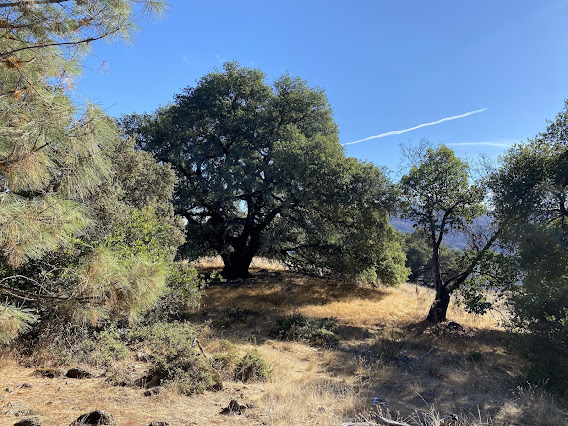Fifth Visit
Name and Location: Lake Sonoma Wildlife Area - No Name Trail
- Time and Date: 11/15/2020; arrival 11:50am, departure ~12:45pm
- Weather: 61 degrees F, wind SW 2mph, no rain, humidity 63%, air quality 16
- Alone or with people?: With fiancé
Rich, green leaves of the oak tree pictured above.
Humidy has gone up through the roof! We're at 63% now, and it feels amazing. When I started my observations it felt very much deserty, and the hot wind would just hit me like a hot wave of wind. Now, the air smells fresh and there's that smell of Sonoma County that we all love oh so dearly. It's one of the reasons why I love Lake Sonoma, Annadel, and Armstrong Redwoods as much as I do.
And don't get me wrong, I love summer in Sonoma County just as much as I love autumn and winter, it's just always the most exciting when we're going through the changes. And there's nothing like the crisp, chilly mornings right now to then after hours of exploring come home, make a fire, and drink some hot chocolate - I don't think anybody ever grows out of that.
Another good aspect of the colder weather is that there is almost literally NO flies, I saw one! ONE!
With less sunlight, the amount of yellow dry leaves and needles on the ground has visibly increased.
For a while we observed some vultures soaring around high up above the tree lines. There are also many red-bellied birds. What do vultures eat besides dead animals? Or is there simply always enough so that doesn't become a problem?
On the plants, I observed less pollen and fruit clusters.
I noticed some big changes on this Wild Buckwheats, it's completely bare now. Back during my second visit, the stems were filled with little clusters of flowers/pollen.
The Gray Pine still has the same amount of Western Dwarf Mistletoe, but instead of being the light yellow-golden, it's now a dark orange color. (Picture above)

















Comments
Post a Comment